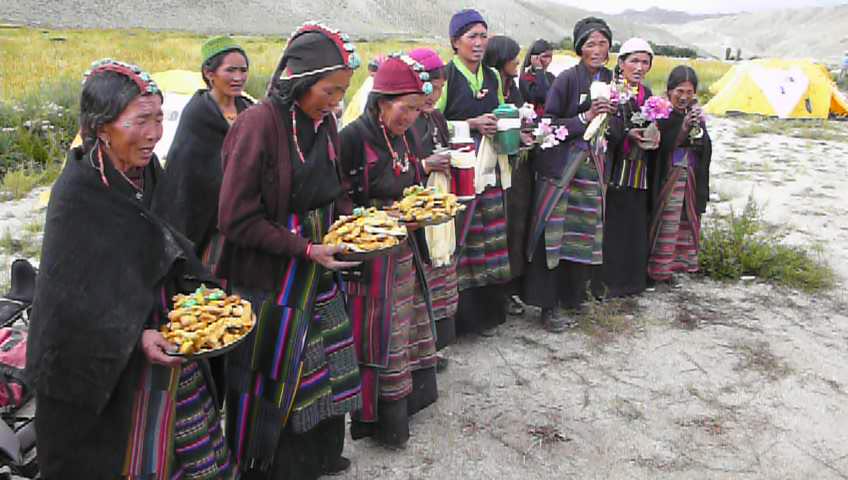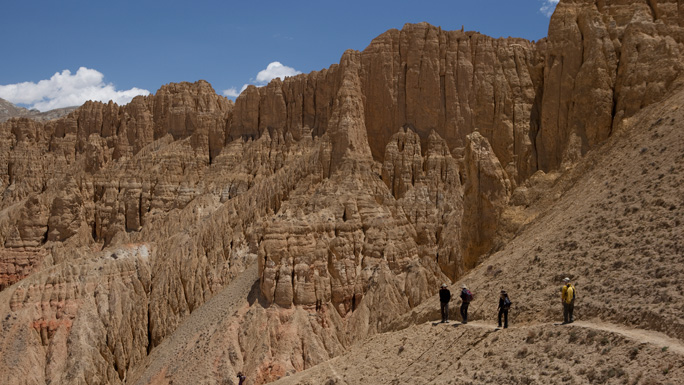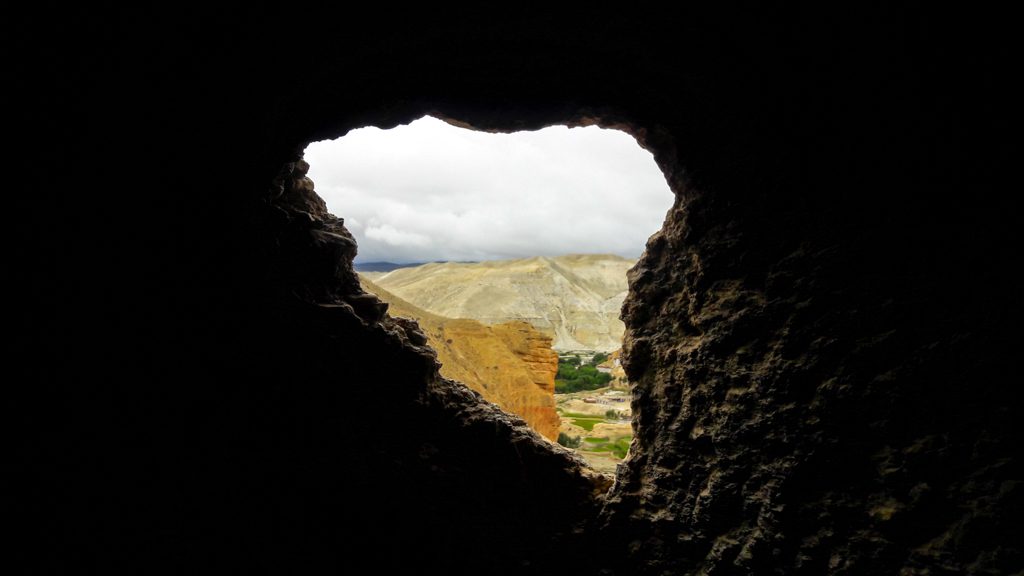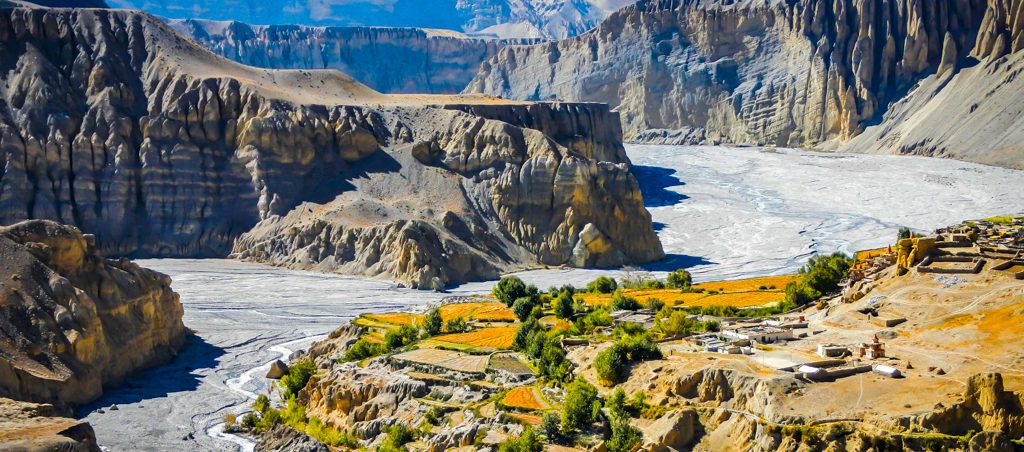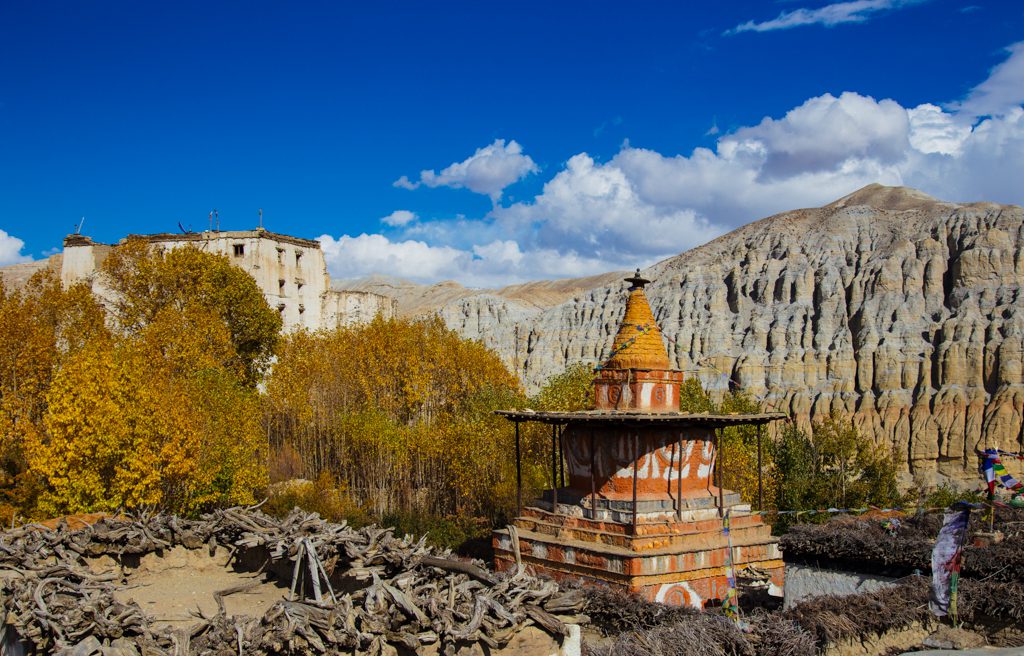Upper Mustang is set within arid an and haunting wilderness amongst wind eroded hills and cliffs, the region edges the border of Tibet. Within the Himalayan Rain Shadow, it makes for a great trekking experience during the monsoon from July to October.
A Kingdom within Nepal for many years, Mustang retained its own monarch until a few years back. The area was first opened to tourists in 1992 and only then with strict limits on the number of people allowed to travel there.
The destination is Lo Manthang, the capital of Upper Mustang. The town was built on the orders of the first King of Lo in 1380 A.D.ThKali our trail follows The Ghandaki Valley with occasional excursions high above the valley walls. Settlements here are scattered with little sign of cultivation between villages, the town stands as a monument to Lo Manthang’s rich history and cultural heritage that flourished centuries ago due to its prominent position on the major ancient salt trade route from Tibet to Nepal.
A Maize of gompas (religious shrines) and houses surround the king’s palace and Lo Mangtang itself is contained within the eight meters high and 700 meters long boundary wall. Along the periphery of the boundary wall are a series of 14 guard towers, built to protect the town from its many envious enemies of the past.
This is a classic trek and extremely rewarding taking you to a very different setting than that which Nepal is known for.
- Cultural heritage tour in Kathmandu
- Exploration of the ancient Lo kingdom in Upper Mustang
- Rugged mountain terrain
- Sublime views of the Himalayas
- View of two 8,000 meters mountains – Mt. Dhaulagiri (8,167m) & Mt. Annapurna I (8,091m)
- Tibetan Buddhist cultural riches of Mustang
- Explore timeless villages and cultures of the region
You will arrive to Kathmandu today. Himalaya Heart representative will welcome you at the airport and take you to the hotel where we will meet to talk about the trip in details. We will discuss any questions you may have in the meeting. The arrival day is your free and relaxing day. There is no activity planned to do except the meeting at the hotel.
A cultural exploration around Kathmandu today.Explore the amazing historic and cultural sites during the full day around Kathmandu. We visit different World Heritage Sites of Kathmandu to learn something about the life in the capital city. The tour mixes culture, history and spirituality together to give you an exceptional city touring experience.
Our whole team leaves for Pokhara today. You will check out the hotel after breakfast and board the vehicle to drive to Pokhara, 200 kilometers west of Kathmandu. The drive will be an excellent experience of Nepali highway drive. The drive will be of about six hours and will go past several towns along the highway. You will enjoy the view of natural surroundings and river valleys.
When we reach Pokhara, it will give you a welcoming gesture with stunning views of the mountains on a clear day. You will have a nice time at leisure to explore the peaceful lakeside and the town.
We are taking an incredible flight to Jomsom alongside the massive mountain range of the Annapurna and Dhaulagiri. About 20 minutes of flight will take us past breathtaking Annapurna range of the Himalayas and through the Kali Gandaki River valley towards Jomsom. We will meet our trekking crew at Jomsom and get ready for the trekking of the day.
We set off on the first day of trekking to Upper Mustang. Our trek for the day will take us to Kagbeni village on the bank of Kali Gandaki River where we stay overnight.
After the formalities of presenting our restricted area trekking permits we set off on our journey, It is a windy region along the valley later in the day so we need to get moving early in the morning ,some good views of Mount Nilgiri glowing orange in the first rays of the sun as we set off. Taking the western route, we follow the east bank of the river until we reach the end of a broad crossing over the river at Chuksang, where we cross the Kali Gandaki. The trail ascends providing a good view of the village, the valley and Nilgiri.We continue eastwards to flat, arid, desert-like land. The scenery is surreal,very characteristic of Mustang with red sandstone pillars and rock formations and colors, formed by thousands of years of erosion and the crust of the land continuing to force its way ever upwards. The first main village we reach is Tangbe with its distinguished red and whitewashed houses, on the other side of the river from here are caves perched high in a vertical wall, which were inhabited in previous times. Chaile from here can be seen as a small white dot at the end of the canyon. The trail descends gradually to the river-bed an area well known for its fossils.Our trek up the valley ends abruptly at a vertical cliff where there is a bridge that crosses the Kali Gandaki river which flows through a natural tunnel in the cliff. The valley narrows further north and a steep trail leads us up to Chaile,Chaile is a small town with some good views towards the Himalayas. Overnight Lodge.
We start with a steep climb following the trail westwards when we reach the viewpoint of Ghyakar on the opposite side of a deep canyon we need to turn right, following the gorge. The landscape is eirie yet stunning, running high up above the path as if gouged out the rock falls in an almost sheer drop for more than 100 meters.An hour or so later we reach a pass that offers a good view of Samar along with the Kali Gandaki Valley with snow-capped peaks in the distance. After trekking through Samar we cross a side-valley, descending to its base before crossing over a creek, then a steep descent up again on the other side. Two hours or so from Samar there is a very interesting red painted cave monastery, which looks as if it is hanging on to the vertical wall. It is very sacred known as Rangchyung Chorten it is one of the most sacred places in Mustang. Its name means ‘the chorten that formed itself’, because inside thereare two large stalagmites in a chorten-like formation. Two famous Buddhist teachers, Padmasambh ava and Atisha stayed in this cave centuries ago. Many prayer flags adorn the ceiling and pilgrims have left small clay figures and other offerings inside.
We then enter a forest type area of small trees and green bushes able to survive in the narrow gorge because of the high vertical walls that keep them cool and sufficiently moist. Soon the valley broadens out as we pass in front of caves which are temporary homes for the herders whose animals graze here. Sometimes it is possible to see the rare blue mountain sheep in this area. The walk to Shyangboche is a long one, it is not that difficult, but a constant climb provoking a feeling that the destination is an illusion, until finally a cluster of houses appear. It is a lot colder here. Overnight Lodge.
Today’s trek begins with the first of today’s three high passes, Yanda La, we trek past a distinctive red Chorten painted with Buddhism’s eight auspicious symbols. From the pass a terraced valley with groups of yellowish trees appears and above the village of Ghelung there are two red Gompas.Ghelung differs from other villages in Mustang, where houses are built close together and look fortress-like. The village is spread out on a wide carpet of green giveing the impression of being a fairly affluent little community. Above the village are barren, brown hills and we can see another pass we need to negotiate Nyi La pass straight ahead. After the pass the path descends gradually towards the Ghami La pass trekking past a rundown, deserted village downstream. By now the landscape is even more rugged – a deep riverbed snakes its way down the red cliffs, ahead are hills resembling enormous red and colourful sand-dunes. Another broad valley approaches from the left side and in its centre is Ghami, Mustang’s third largest town. Ghami sits high above the river and surrounded by fields. Overnight Lodge.
On leaving Ghami we pass an incredible Mani (parayer) wall – approximately 1000m long and Mustangs longest. It is decorated with simple carvings and very much typical and in tune with the surrounding scenery. A group of Chortens stand erect in front of the red wall which forms the end of the valley.The architecture is hard to distinguish going hand in handmore like an organic extension of the nature here. The legend here of which there are many is on the death of the famous Guru Rinpoche (Padmasambhava) who came to the area to fight and destroy a demon, its intestines landed at the site where the Mani wall stands, its lungs near the red cliffs behind and its heart at the spot where Mustang’s oldest monastery, Lo Gekar, was built. We make a steady climb up to a pass 3820m where a lunar-looking stretches as far as the eye can see. This is barren country with no sign of vegetation or human life, hill after barren hill with a distinctively haunting beauty. The first indication of human life is found at the Tsarang Chorten – the large red-painted Stupa standing alone, further down the trail the monastery palace of Tsarang can be distinguished in the fields. A wide road leads us to Tsarang, Mustang’s second town, with around 1000 inhabitants. Overnight Lodge
We start today along flat terrain apart from a chorten and a few caves it is barrenness all the way. We cross over a pass through two rocks that form a natural gate to finally reach our destination the ancient Kingdom Lo Manthang where we spend two nights with a full day to soak up Lo Manthang.
The day is set aside to explore the cultural wonders of Lo Manthang and its surroundings today. We visit three major gompas of the town namely Jhampa, Thupchen and Chhoeda. All of these gompas have undergone expert restoration over the last two decades. We also have the optional trek to Tingkhar which is a beautiful village located north-west of Lo-Mangthang. Overnight in Lo Manthang.
As we have already reached the final destination of the trek, we trek back to Dhakmar today. With a trek over Marang La, a high Himalayan pass, which stands at the elevation of 4,300 meters, wonderful views.We take a different route back on our return from Lo-Manthang. Our trail passes through Gyakar village which houses a century old Ghar Gompa with some interesting rock paintings. According to a local legend, anyone who makes a wish at the Gompa will have it fulfilled. We explore the Gompa and continue our trek to Drakmar for our overnight stay.
We start our trek early to avoid strong winds prevalent to this particular area, most of the day is spent descending. Our trail passes through a dry plateau and fields before reaching Ghiling. The walk can be quite difficult at times as we are most likely to experience strong winds against us. Ghiling has some good views of Dhaulagiri and Nilgiri mountains. We have enough time to look around the village in the evening. Overnight in Ghiling.
We begin our trek after breakfast we are now walking on the same trail as we did on the way up to Lo Manthang. There are some great views of the Himalayas and small villages we pass en route. Overnight in Chhuksang
We start today with with an uphill to reach a pass of 3970m. From here we have a beautiful view of the white capped mountains and barren landscape of Mustang. Then it is downhill to Muktinath. a world famous pilgrimage for all the Hindus and many Buddhists. It is a moderate walk down to Muktinath, with stunning views of Dhaulagiri and Annapurna. There are 108 springs which have their source in or around Muktinath and bathing here is believed to bring good luck. Many people also collect the spring water in bottles to take home to relatives. Also at Muktinath there is the legendary flame coming out of a rock, around which a Buddhist temple has been created.We overnight here.
The last day of the trek We trek back to Jomsom an easy day as we are descending we stop at Kagbeni for lunch before continuing on to Jomsom for our final night in the mountains.Time to reflect have a hot shower and some good food.
Time to say goodbye to what has been a truly amazing experience. After breakfast we go to the airport to catch the flight to Pokhara. The flight is a fitting end to a wonderful trek as we cut through the Annapurnas with inspiring views of both the Annapurna and Dhaulagiri Himalayan Ranges. Upon arrival at Pokhara and after the transfer to the hotel the rest of the day is free to explore this beautiful lake town, chill out in a restaurant by the lake or go boating .The mountains however have not left us as Pokhara has perhaps the best mountain backdrop anywhere in the world. Overnight Hotel.
Drive back to Kathmandu and transfer to our hotel the rest of the day is free. You also have an option to fly back to Kathmandu at an additional cost.We usually organise a farewell dinner.
Today its time to move on we hope you have had a great time with us and we would like to meet again in the future. If you are flying today.we will drop you at the airport as per your flight schedule or assist you with any other move.
Cost Include
- Pick up & drop off on your arrival and departure
- Hotel accommodations in Kathmandu and Pokhara with breakfast
- Basic lodge accommodation during the trek
- A professional trekking guide and necessary number of porters [one porter in between two people]
- Special trekking Entry permit and TIMS (Trekkers Information Management System)
- Breakfast, lunch, dinner during trek
- Pokhara - Jomsom - Pokhara flight ticket
- Road transportation
- Emergency rescue arrangement (Make sure your insurance will cover it)
- Insurance for guide that includes their emergency rescue
- Necessary equipment for guide & porter
- First aid kits
Cost Not Included
- Meals in Kathmandu and Pokhara
- Alcohol and any drinks on the trip
- Tips for guide and porters
- All expenses of a personal nature e.g. toilet paper, medicines, and confectionery etc.
- Private transport if needed
- Any other cost raised by unforeseen circumstances
Upper Mustang FAQ's
You can bring your own light-weight sleeping bag from home or you can rent one in Kathmandu or Himalaya Heart will loan you one. Most tea houses also have blankets you can use; in the warmer months, you may just want a sleeping bag liner to use with the blankets, and in the colder months, you’ll want a warmer winter sleeping bag.
Yes. All of the necessary permits and conservation fees for your trek are included in the price and will be arranged for you by Himalaya Heart prior to your trek. (we prefer doing this on line before your arrival) For certain restricted regions (like Manaslu and Upper Mustang) we need to have a full day in Kathmandu prior to your trek as we need your passport for the permit registration.
You can leave your additional luggage at your hotel in Kathmandu or at our company office in Thamel. Either way, your luggage will be waiting for you at your hotel when you return back from your trek.
You can buy virtually everything you need for trekking from down jackets to water bottles in Kathmandu. There is a variety of branded stores as well as a large selection of copied products mainly in Thamel that are of fairly good quality. It’s still worth bringing your own gear if it doesn’t take up too much weight, especially your own trekking boots to avoid any potential issues when purchasing new shoes..
You should bring trekking boots that are comfortable and broken in. There can be some snow at higher altitudes especially when crossing high passes, so it’s good to be prepared for a variety of conditions. Your footwear should be strong and durable. It should have a chunky sole—preferably made of Vibram or another durable material—and should also protect your ankles..
Tipping is not required but is expected, and really depends on how happy you were with the service. Guides (both for trekking and cultural tours), porters, and drivers are typically provided with a tip at the end of their service with you..
Most days in the mountains involve 4-6 hours of trekking. When you consider your day starts at 8 am and ends around 4-5 pm, it’s not too arduous as you’ll be taking a number of breaks and stopping for lunch along the way. The higher you get in elevation (especially in the Everest region), the shorter your trekking days will get to ensure we minimize the risk of altitude sickness.
All of our guides at Himalaya Heart speak English and have had many years of experience in guiding foreign travelers. It’s a requirement that they all are trained in first aid as well and we carry a first aid kit during the trek.
If you fall ill during your trek, the course of action depends on what’s wrong. If it’s altitude sickness, moving to lower altitudes and taking altitude medication will solve this in most cases; if it’s severe, our guide will arrange for an emergency evacuation by helicopter Himalayan Heart will cover the initial costs then claim from your insurer (be sure that emergency helicopter rescue is covered in your travel insurance it is an essential requirement before travelling with us). If you have stomach sickness or another type of food or water-related illness, our guide will have medication on-hand for most common illnesses.
General FAQs on Nepal:
When’s the best time to visit Nepal?
The main seasons for trekking are the spring (Mar to May) and autumn (Sep to Nov) when you’ll have clear skies and superb mountain views. The winter (Dec to Feb) is also a great time to visit— these months offer a unique experience and fewer crowds but lower altitude treks are better at this time of year as its cold at night.
What’s it like during the monsoon season?
During the monsoon season (Jun to Aug), most of Nepal experiences heavy rain for a few hours each day. It’s humid, wet, and the trails in the lower regions (Ghorepani, Ghandruk, Langtang, etc) can be quite muddy. If you don’t mind the rain you’ll have the trails to yourself, the skies often clear up in the morning, and certain treks offer stone-paved trails that drain the rain and make for easy trekking. Also, certain regions, like Mustang and the upper reaches of Everest, lie in the rainshadow of the Himalaya and receive little rain but views however are still likely to be restricted.
What’s the difference between private and group tours?
Private tours are tailor-made itineraries built by us around your travel dates and personal interests, whereas group trips are pre-packaged and depart on specific dates. Group trips are also open for others to join, whereas private trips are just for you. You will find a list of fixed departure dates on our website.
How do I get my visa for Nepal?
For most nationalities, you can get your visa on arrival in Kathmandu. It takes around 45 minutes and is the most convenient way to get your visa you will need passport size photos.. You can also apply for a visa in advance from a local Nepali consulate in your country if you’d like to have everything arranged in advance. Cost15 Days – 25 USD / 30 Days – 40 USD / 90 Days – 100 USD
How much luggage can I take on domestic flights?
For mountain flights, you’re allowed 5 kg. carry-on to the plane and 10 kg. for checked-in luggage. For non-mountain sector flights, the check-in allowance increases to 20-25 kg.
How many days should I spend in Nepal?
If you’re mainly looking to experience Nepal’s cultural and natural highlights, you can have a great experience in 5-9 days, where you can visit two regions (likely Kathmandu and Pokhara perhaps go on Safari at Chitwan). If you intend to go trekking consider at least 10 days (more is better) to have enough time to reach higher altitudes and safely acclimatize if need be.To undertake one of the longer, classic treks in Nepal or to combine multiple regions and activities into one visit, think about 14-20 days and more if possible.
Are hotels included in the tour price?
Himalaya Heart organises complete tours, meaning everything is taken care of from the moment you arrive in Nepal to the moment you leave, including all of your accommodation in a three star Hotel. If you require better accommodation please let us know and we can arrange this and adjust the tour cost accordingly. Each of our tour pages shows clearly what is and what is not included in the tour price.
Are there any extra expenses not included in my tour price?
Personal expenses (tips, soft drinks, bar bills, laundry, telephone calls, donations, and extra snacks, etc) are not included in your tour price. When checking a particular trek page on our website we have clearly stated what is and what is not included. If you’re going trekking, the only things you’ll need to pay for out of pocket are wifi and battery charging (when available), extra meals outside of what’s included, alcohol, and soft drinks and perhaps hot showers.

 +977 9851093973 (Thakur)
+977 9851093973 (Thakur)